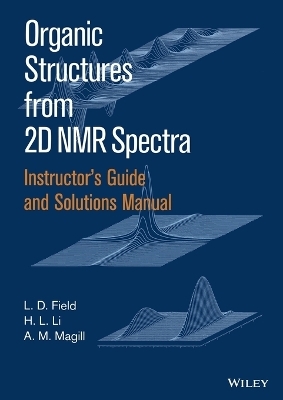
Instructor's Guide and Solutions Manual to Organic Structures from 2D NMR Spectra
John Wiley & Sons Inc (Verlag)
978-1-119-02725-6 (ISBN)
The text Organic Structures from 2D NMR Spectra contains a graded set of structural problems employing 2D-NMR spectroscopy. The Instructors Guide and Solutions Manual to Organic Structures from 2D NMR Spectra is a set of step-by-step worked solutions to every problem in Organic Structures from 2D NMR Spectra. While it is absolutely clear that there are many ways to get to the correct solution of any of the problems, the instructors guide contains at least one complete pathway to every one of the questions. In addition, the instructors guide carefully rationalises every peak in every spectrum in relation to the correct structure. The Instructors Guide and Solutions Manual to Organic Structures from 2D NMR Spectra: Is a complete set of worked solutions to the problems contained in Organic Structures from 2D NMR Spectra. Provides a step-by-step description of the process to derive structures from spectra as well as annotated 2D spectra indicating the origin of every cross peak. Highlights common artefacts and re-enforces the important characteristics of the most common techniques 2D NMR techniques including COSY, NOESY, HMBC, TOCSY, CH-Correlation and multiplicity-edited C-H Correlation. This guide is an essential aid to those teachers, lecturers and instructors who use Organic Structures from 2D NMR as a text to teach students of Chemistry, Pharmacy, Biochemistry and those taking courses in Organic Chemistry.
L. D. Field is the author of Instructor's Guide and Solutions Manual to Organic Structures from 2D NMR Spectra, published by Wiley. A. M. Magill is the author of Instructor's Guide and Solutions Manual to Organic Structures from 2D NMR Spectra, published by Wiley.
Preface ix
Solutions Summary 1
Problem 1 (1-iodopropane) 7
Problem 2 (2-butanone) 11
Problem 3 (2-hexanone) 15
Problem 4 (ethyl propionate) 19
Problem 5 (ethyl 3-ethoxypropionate) 23
Problem 6 (4-acetylbutyric acid) 28
Problem 7 (3-ethoxypropionyl chloride) 32
Problem 8 (ethyl 3-chloropropionate) 36
Problem 9 (isoamyl acetate) 40
Problem 10 (trans-4-hexen-3-one) 45
Problem 11 (trans-2-octen-4-one) 50
Problem 12 (3-nitrobenzaldehyde) 55
Problem 13 (3-iodotoluene) 61
Problem 14 (8-hydroxy-5-nitroquinoline) 64
Problem 15 (2-bromo-3-picoline) 69
Problem 16 (trans-anethole) 72
Problem 17 (cis-2-pentene) 75
Problem 18 (p-tolyl benzoate) 79
Problem 19 (phenyl p-toluate) 86
Problem 20 (4-biphenylyl acetate) 93
Problem 21 (4 ′ -phenoxyacetophenone) 99
Problem 22 (4 ′ -tert-butylacetophenone) 106
Problem 23 (2,2,4 ′ -trimethylpropiophenone) 110
Problem 24 (trans-2-methyl-3-phenyl-2-propen-1-ol) 114
Problem 25 (methyl 4-ethoxybenzoate) 119
Problem 26 (methyl 3-(p-tolyl)propionate) 123
Problem 27 (4-(4 ′ -methoxyphenyl)-2-butanone) 127
Problem 28 (ethyl 6-bromohexanoate) 132
Problem 29 (piperonal) 135
Problem 30 (cis-3-hexenyl benzoate) 139
Problem 31 (trans-2,cis-6-nonadienal) 146
Problem 32 (allyl glycidyl ether) 155
Problem 33 (3,4-epoxy-4-methyl-2-pentanone) 159
Problem 34 (dl-methionine) 162
Problem 35 (N-acetyl-l-leucine) 165
Problem 36 (isoamyl valerate) 170
Problem 37 ((E)-4-methyl-4 ′ -nitrostilbene) 173
Problem 38 (2-tert-butyl-6-methylphenol) 181
Problem 39 (2-allyl-6-methylphenol) 186
Problem 40 (2-hydroxy-4-methoxybenzaldehyde) 194
Problem 41 (2 ′ -hydroxy-5 ′ -methylacetophenone) 198
Problem 42 (3 ′ -fluoro-4 ′ -methoxyacetophenone) 203
Problem 43 (trans-ferulic acid) 209
Problem 44 (sec-butyl 3-hydroxycinnamate) 215
Problem 45 (1-benzosuberone) 221
Problem 46 (dimethyl (3-bromopropyl)phosphonate) 228
Problem 47 (caffeine) 233
Problem 48 (benzyloxypropionitrile) 238
Problem 49 (cineole) 242
Problem 50 (thymoquinone) 246
Problem 51 (4-bromo-1-indanol) 251
Problem 52 (1-bromo-4-methylnaphthalene) 257
Problem 53 (carvacrol) 264
Problem 54 (acetoacetanilide) 272
Problem 55 (ethyl acetamidocyanoacetate) 277
Problem 56 (α-humulene) 283
Problem 57 (3,4-dihydro-2H-benzopyran-3-carboxylic acid) 289
Problem 58 (quinidine) 296
Problem 59 (salbutamol) 312
Problem 60 (2-hydroxy-1-naphthaldehyde) 322
Problem 61 (6-methyl-4-chromanone) 329
Problem 62 (citronellal) 336
Problem 63 ((+)-cis-2-oxabicyclo-[3.3.0]oct-6-en-3-one) 344
Problem 64 (melatonin) 349
Problem 65 (carvone) 362
Problem 66 (haloperidol) 370
| Erscheint lt. Verlag | 15.6.2015 |
|---|---|
| Verlagsort | New York |
| Sprache | englisch |
| Maße | 208 x 295 mm |
| Gewicht | 1043 g |
| Themenwelt | Medizin / Pharmazie ► Medizinische Fachgebiete |
| Naturwissenschaften ► Chemie ► Analytische Chemie | |
| ISBN-10 | 1-119-02725-X / 111902725X |
| ISBN-13 | 978-1-119-02725-6 / 9781119027256 |
| Zustand | Neuware |
| Haben Sie eine Frage zum Produkt? |
aus dem Bereich


